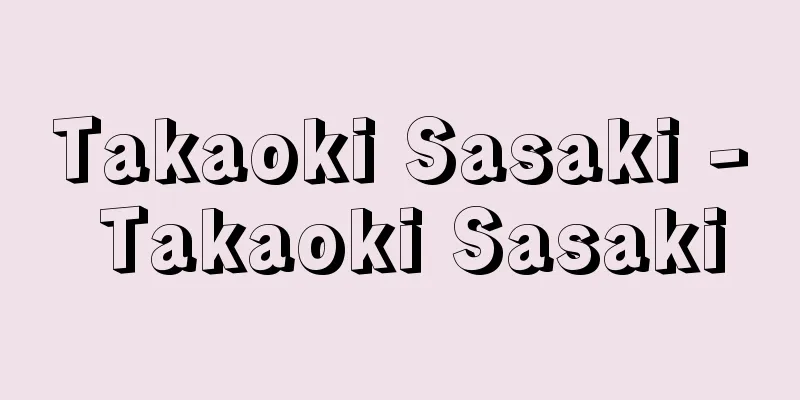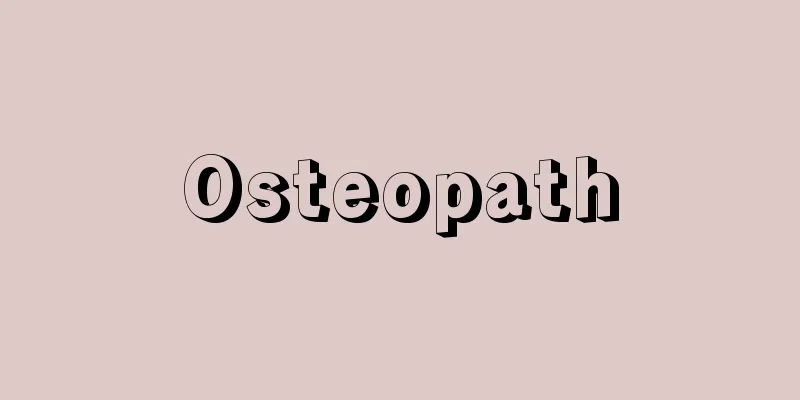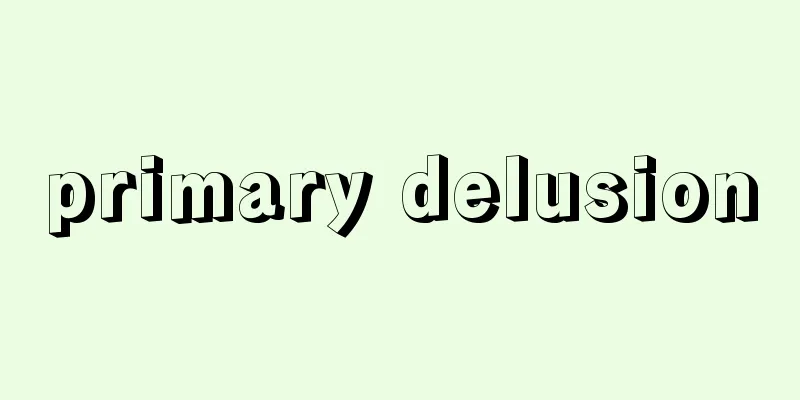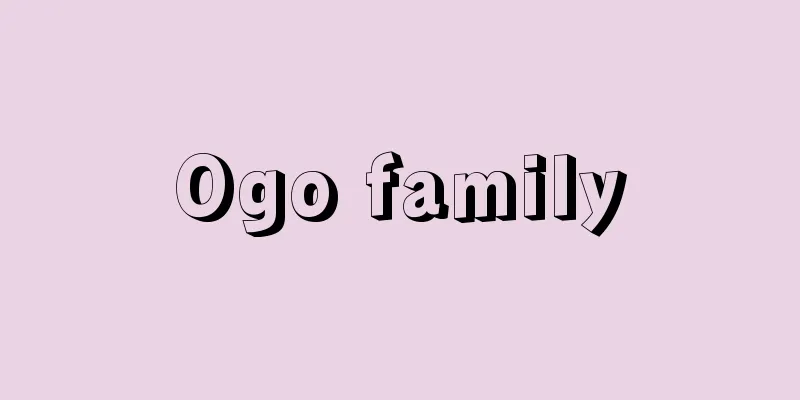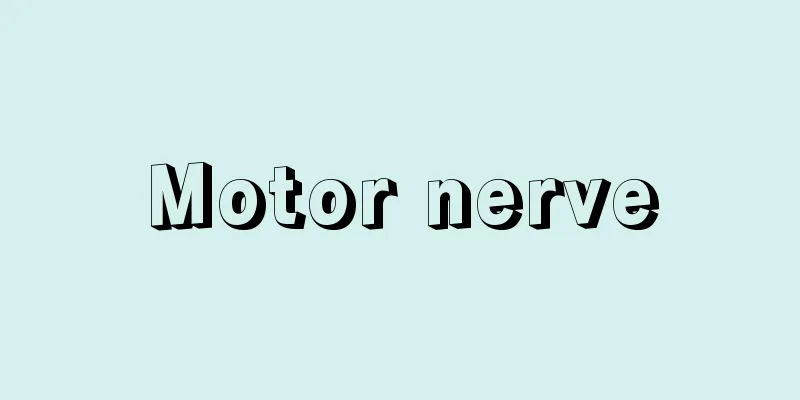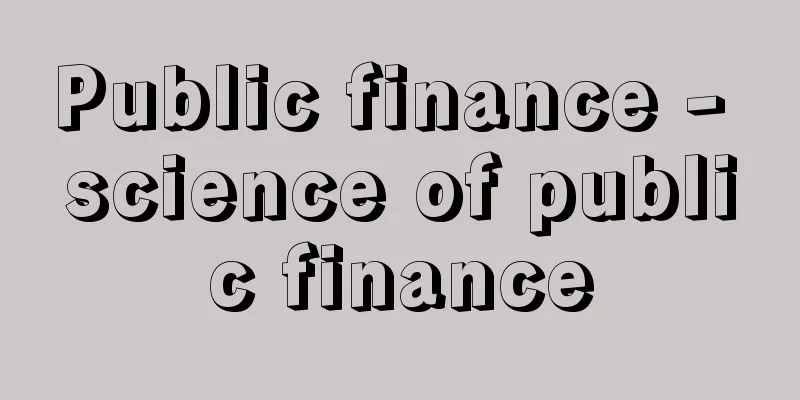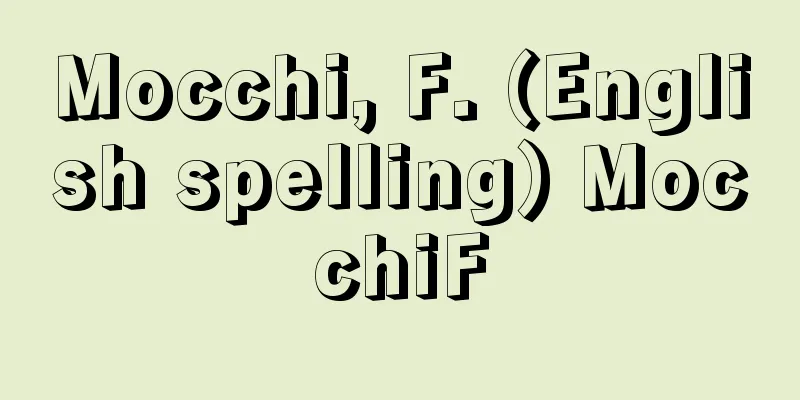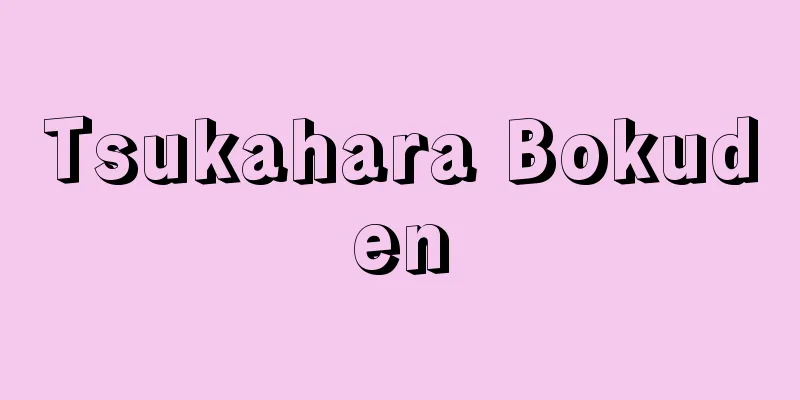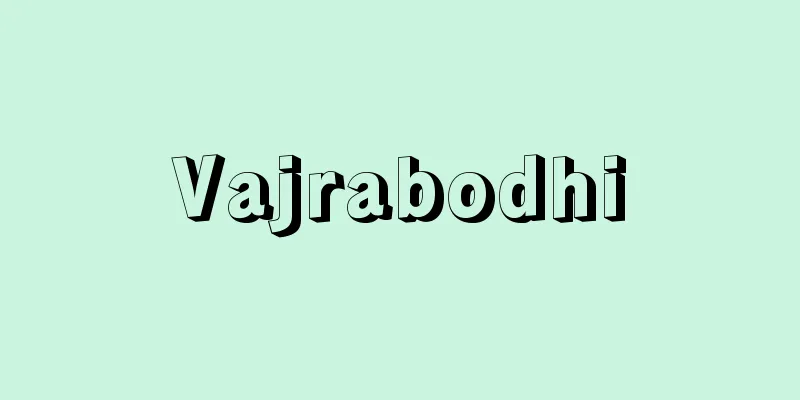Chinese medicine - Kanpouigaku

|
Kampo is a general term for medicine that was developed in Japan after it was introduced to Japan from ancient China. Kampo is a term used in contrast to Dutch medicine, which was called Ranpo. There are two types of Kampo medicine: Goseho, which is based on medicine introduced from China at the end of the Muromachi period, and Koho, which is based on ancient Chinese medicine (Shokanron and Kinkiyoryaku) that arose in the mid-Edo period. Most of the Kampo medicine practiced today is a combination of the two, and is more or less based on Koho. On the other hand, Oriental medicine was used to refer to a wide range of Oriental medicine, including Indian medicine and Chinese medicine, but today it is often used to mean Kampo medicine. Indian medicine is called Ayurvedic medicine or Sushruta medicine, and Chinese medicine is called Chinese medicine, to avoid confusing Oriental medicine and Kampo medicine. [Shigeru Ariji] historyAncient Chinese medicine, which forms the basis of traditional Chinese medicine, was systematized about 2,000 years ago. The original text on medical treatment is the "Huangdi Neijing," the original text on drugs is the "Shennong Bencao Jing," and the original text on drug therapy is the "Lun of Febrile and Miscellaneous Diseases" (later split into the "Lun of Febrile" and "Jingui Yaolue"), and these developed separately. From the "Huangdi Neijing," books on acupuncture and moxibustion such as the "Acupuncture and Moxibustion Jia Yi Jing" were created, and acupuncture and moxibustion techniques developed. From the "Shennong Bencao Jing," which can be said to be the oldest Chinese pharmacopoeia, representative herbal books such as the "Ming Dynasty Compendium of Materia Medica" and the "Yamato Honzo" and "Mangyo Gangmu Qimou" of the Edo period were created. Furthermore, the contents of the drug therapy contained in "Shanghan Lun" and "Jingui Yaolue" have been passed down unchanged to the present day. However, Chinese medicine also changed over time. In particular, during the Jin and Yuan dynasties, it changed so much that it came to be known as "Jin and Yuan medicine." This medicine was brought back to Japan by the physician Tashiro Sanki at the end of the Muromachi period and became established there. These people who took the position of Jin and Yuan medicine were called the Gosei school, and this medicine was called Gosei school. Meanwhile, in China, during the Qing dynasty, the "Iso Kinkan" was compiled by imperial decree, and its contents were a culmination of Chinese medicine at the time. Furthermore, books such as "Onbyouron" and "Onekiron" were compiled during the Qing dynasty, and these continue into today's Chinese medicine. Manase Dosan further expanded the Jin-Yuan medicine that Tashiro Miki brought back, and wrote books such as "Keitekishu" and "Kirigami". After that, until the early Edo period, Jin-Yuan medicine was significantly Japanized, and when people spoke of medicine, they meant Goseiho, but then in the mid-Edo period, a restorationist ideology, such as that seen in the revival of national learning, arose, and in response, physicians who believed that medicine should "return to the roots of ancient Chinese medicine" appeared. In the early days of this restorationist stance, Nagoya Gen'i, Goto Konzan, Kagawa Shuan, and others were active, and it reached its peak of development with Yamawaki Toyo and especially Yoshimasu Toudo. The people who practiced these medicines are called the Koho school, and this medicine is called Koho. Yoshimasu Toudou is also known as the "father of ancient medicine." Ancient medicine was based mainly on the Treatise on Shanghan Lun, but its contents were an assimilation and transformation of ancient Chinese medicine into a uniquely Japanese medical method, placing emphasis on abdominal palpation (fukushin), i.e. palpation of the abdomen, and neglecting pulse diagnosis (diagnosis by pulse). Yoshimasu Toudou was a representative of this method, and wrote the books Ruijuho, Hokyo, and Yakucho. Abdominal palpation in particular developed uniquely in Japan, and many books on abdominal palpation were published. These include Inaba Bunrei's Fukusho Kiran and Wakuda Toshitora's Fukusho Kiranshu. Ancient medicine, based on "intense aggressive therapy" using simple prescriptions, became popular in the era of restorationist thinking, and produced physicians such as Nagatomi Dokushoan and Odai Yodo, and the ancient school of medicine became the mainstream of medicine in Japan. However, a third school was soon born that took the position of blending ancient medicine with later methods and integrating the advantages of each. This is called the eclectic school, and its main members were Wada Tokaku, author of "Dousui Sogen" and "Shoso Hoikai," and Arimochi Keiri, author of "Hoyogei." This eclectic school also gradually fell into empiricism, and a school that placed even more emphasis on the verification of ancient documents emerged, the evidence school, centered around the Taki family of the Edo Medical School. Mori Risshi, Kitamura Chokkan, and Hara Nanyo, who wrote "Sokeitei Iji Shogen," were key members of the evidence school. Also, Asada Sohaku, who is said to be the last great doctor of Chinese medicine in the Meiji era, belonged to this school. Towards the end of the Edo period, Dutch medicine (Ranpo-gaku) became popular and a combination of Chinese and Dutch medicines began to be practiced. One example of this was Hanaoka Seishu's use of Chinese medicine and Japanese folk medicines in breast cancer surgery under general anesthesia. In the Meiji era, the government banned Kampo medicine and adopted Western medicine, mainly German medicine, which forced Kampo medicine to decline. However, in recent years, Kampo medicine has been re-evaluated for its unique characteristics. It is not left as it was in the Edo period, but is being scientifically reexamined as Kampo medicine within modern medicine, and efforts are being made to utilize its merits. It is hoped that the combined use of Western medicine and Kampo medicine will contribute to medical care in the future. [Shigeru Ariji] TreatmentAs mentioned above, Kampo medicine, unlike modern medicine, was created in an ancient time when the names of diseases were not yet established, and therefore the method of recognizing the condition of a disease is diagnosis by the five senses, namely the eyes, ears, nose, tongue, and body. Kampo medicine first grasps the symptoms perceived by the patient and others through the five senses, and determines the combination of symptoms, or syndrome. This is called "Sho" in Kampo medicine, and determining this Sho is the same as determining the treatment. Sho is a unified whole after selecting and discarding the necessary symptoms and establishing their interrelationships. It corresponds to the diagnosis of a disease in modern medicine, but Sho is also the indication for a prescription. In other words, the Sho for Kakkonto is the syndrome for which Kakkonto is effective, and the fact that diagnosis is the same as treatment is a characteristic of Kampo medicine, which is fundamentally different from modern medicine, which determines the treatment plan after diagnosing the disease. This is called "consistency of the formula and symptoms" and "treatment according to the symptoms," and here lies the practical philosophy of ancient China. However, there are significant differences between traditional Chinese medicine and Japanese Kampo medicine, especially the traditional treatment based on symptoms. In Japan, treatment is based mainly on abdominal diagnosis, which, as mentioned above, developed uniquely in Japan. Examinations to determine a patient's condition can be divided into four categories: inspection, questioning, auscultation, and palpation. Inspection involves visual examination, which examines the overall condition of the patient's body, and tongue examination, which examines the condition of the tongue. Questioning involves learning about the patient's medical history and condition through a dialogue with the patient. Auscultation involves listening to the patient's breathing and cough, and smelling excrement, while palpation can be divided into pulse examination, which examines the pulse by pressing it with the fingers, and abdominal examination, which involves palpating the abdomen to grasp symptoms. The above four examinations are used to examine the whole body, that is, to determine the condition, but pulse diagnosis and abdominal diagnosis are particularly essential. In modern medicine, pulse diagnosis mainly looks at the number of pulses (per minute), stagnation, hardness or softness of the arterial walls, and the tortuosity of the blood vessels, but in Chinese medicine, many other conditions such as rising and falling, tightness or softness, and size are grasped and these are combined to diagnose the state of the body and the location of the disease, and then a prescription (Chinese herbal medicine) is decided. Furthermore, abdominal diagnosis, which is considered the most important, is completely different from modern medicine. It does not involve palpating the liver, stomach, intestines, and other organs to check for swelling, hardness or softness, tenderness, or tumors, but rather stretching the knee joint to relieve tension in the abdominal wall and grasping the condition of tenderness and resistance of the abdominal wall and its location. The condition obtained through this abdominal diagnosis is the basis for matching the prescription and condition. In addition to the four types of examination, there is also the diagnosis of the whole body. This includes methods of dividing physical strength into deficiency and excess based on the pulse and muscle tension, blood circulation into congestion and ischemia (intracapillary deficiency, which is different from anemia), and heat into hot and cold sensations, as well as methods of dividing the body into external and internal based on the pulse pattern and skin anhidrosis, sweating, diarrhea, vomiting, etc. Furthermore, symptoms are sometimes divided into qi (ki), blood (ketsu) and water (sui) and diagnosed. This is the idea that health is achieved when the balance of qi, blood and water is well maintained. Any abnormality in the autonomic nervous system, mental state, breathing, etc. is a "disease of qi (ki stagnation)," whereas symptoms such as congestion, congestion, dilated skin capillaries, dark red tongue edges and lower abdominal tenderness are "blood blood (kessho) (blood stasis)," and swelling, especially swelling that does not subside when pressed, dry mouth (thirst and a desire to drink water), oliguria and general fatigue are "water poisoning (water stagnation)." Based on these symptoms, qi medicines are administered for "disease of qi," blood medicines for "blood medicine," and diuretics for "water poisoning." Once the condition is determined based on the symptoms of the whole body and the pulse, the prescription is decided using a key-and-lock system. The prescription is not selected according to the name of the disease as in modern medicine, but is determined entirely by the condition. For example, even if you have a fever, if you feel chills without sweating, you may be in for Kakkonto, if you have pain in the joints of your limbs, you may be in for Mao Tang, and if your physical strength is low and you have the symptoms mentioned above, you may be in for Keishi Tang. In this way, the prescription is determined based on the condition. [Shigeru Ariji] Relationship with modern medicineAs mentioned above, there is a big difference between the diagnosis and treatment of Kampo medicine and modern medicine, but this has resulted in Kampo medicine being reevaluated and reappearing today. Before World War II, intractable diseases were "infectious diseases," such as typhoid fever, dysentery, and tuberculosis, but these infectious diseases were overcome with the advent of antibiotics. Instead, today's intractable diseases are "immuno-genetic diseases" such as hepatitis, nephritis, rheumatism, and bronchial asthma, and "genetic metabolic diseases" such as diabetes and gout. Modern medicine treats these diseases as immune diseases and metabolic diseases, but this has not produced any results. This is because genetic factors and individual differences are major contributing factors. However, Kampo diagnosis is a treatment and diagnosis method that includes genetic factors and individual differences. This is why Kampo medicine is being reevaluated today. In the case of infectious diseases, the diagnosis of the disease is the same as the diagnosis of the treatment, and antibiotics are decided once the disease is named, but this is not the case for the aforementioned modern intractable diseases. For example, in the case of hepatitis, even if the medical history, sex, age, and condition are the same, the effective medicine is not the same. There is a large difference between individuals. In particular, there is a large difference between individuals with steroids. In addition, just like effectiveness, there is also a large difference between individuals in side effects. However, Chinese herbal medicine is effective against these intractable diseases because it is composed of herbal medicines that have anti-allergic and cell-activating effects (the effect of increasing cell activity). Furthermore, Chinese herbal medicine is often more effective than chemical drugs because it is used according to the condition, that is, the condition caused by the individual's genetic and environmental factors. In this way, the effectiveness of today's treatment of intractable diseases is increased by combining modern medicine, which performs medical diagnosis, and Chinese herbal medicine, which performs medical diagnosis. When Kampo medicines are used as treatments in modern medicine, they naturally have a range of applications. Psychosomatic disorders, hepatitis, nephrosis, chronic gastroenteritis, and prevention of aftereffects of surgery are absolute indications for Kampo medicines, while rheumatism, bronchial asthma, nephritis, and high blood pressure are relative indications. In this case, it is necessary to use chemical drugs in some conditions and Kampo medicine in other conditions. Steroids, which are often used for these intractable diseases, are the second most valuable drug after antibiotics, but they are currently difficult to use due to their side effects. When these steroids are used in combination with Kampo medicines such as Bupleurum Root and Blood Pumping Agents, their effectiveness can be enhanced and side effects can be reduced. Even in the case of chemotherapy drugs used as anticancer drugs, side effects can be reduced by using Kampo medicines in combination. In this way, using modern medicine's chemical drugs in combination with Kampo medicines leads to improved therapeutic effects. Modern medicine has a field called "preventive medicine," but Kampo medicine has a concept called "pre-illness medicine." Pre-illness means "stopping the disease before it develops." While modern preventive medicine has developed with a focus on preventing infectious diseases, pre-illness medicine has focused on preventing lifestyle-related diseases (adult diseases) and diseases that are equivalent to modern incurable diseases. Pre-illness medicine can be said to be primary health care. In other words, it is possible to predict the onset of disease based on symptoms that appear before the disease develops, and by administering Kampo medicine that matches the symptoms, the symptoms will disappear, "curing the disease at the pre-illness stage," and preventing the disease from developing. This is another major difference between modern medicine and Kampo medicine. [Shigeru Ariji] [References] | | | |Volume 1, Part 1, Written by Lee Si-chin, Published in 1637 (Kan'ei 14), held at the National Diet Library "Compendium of Materia Medica" Volume 1: Ranzan Ono's Oral Lectures, Published in 1803 (Kyowa 3), held at the National Diet Library "Enlightenment of the Compendium of Materia Medica" Source: Shogakukan Encyclopedia Nipponica About Encyclopedia Nipponica Information | Legend |
|
古代中国で発達した医学が日本に伝えられ、日本の風土のなかで発展した医学の総称であり、漢方とは、オランダ医学を蘭方(らんぽう)とよんだのに対して使われた用語である。漢方医学には、中国から室町時代末期に伝来した医学を基礎とする後世方(ごせほう)と、江戸時代中期におこった中国の古代医学(『傷寒論(しょうかんろん)』『金匱要略(きんきようりゃく)』)を基礎とする古方(こほう)とがあるが、現在行われている漢方医学の多くは両者を折衷したものであり、どちらかというと古方を主体としているといえる。一方、東洋医学というのは、インド医学、中国医学など東洋の医学を広くさして使われていたが、今日では漢方医学を意味して使われる場合が多い。なお、インド医学をアーユルベーダ医学、スシュルタ医学とよび、中国医学を中医学などとよんで、東洋医学、漢方医学との混用を避けている。 [有地 滋] 歴史漢方医学の基礎となる古代中国医学は約2000年前に体系づけられた。医療に関する原典が『黄帝内経(こうていだいけい)』、薬物に関する原典が『神農本草経(しんのうほんぞうきょう)』、薬物療法の原典が『傷寒雑病論(しょうかんざつびょうろん)』(のちに『傷寒論』『金匱要略』に分かれたとされる)であり、これらがそれぞれに発展してきた。『黄帝内経』から『鍼灸甲乙経(しんきゅうこうおつきょう)』のような鍼灸の書がつくられ、鍼灸術が発達した。最古の中国薬局方ともいうべき『神農本草経』からは、明(みん)代の『本草綱目(ほんぞうこうもく)』、江戸時代の『大和本草(やまとほんぞう)』『本草綱目啓蒙(けいもう)』などの代表的な本草書がつくられた。また、『傷寒論』『金匱要略』の薬物療法の内容は、そのまま現在まで引き継がれている。 しかし、時代とともに中国の医学も変貌(へんぼう)してきた。とくに金(きん)・元(げん)時代には、「金元医学」といわれるほどに変化した。この医学が室町時代末期の医家田代三喜(たしろさんき)によって日本に持ち帰られて定着した。これら金元医学の立場をとる人々を後世方派といい、この医学を後世方という。一方、中国では、清(しん)代になると勅命によって『医宗金鑑(いそうきんかん)』が編纂(へんさん)されたが、その内容は当時の中国医学を集大成したものであった。さらに『温病論(おんびょうろん)』『温疫論(おんえきろん)』といった書も清代に編まれ、これらが今日の中国医学へと続くのである。 田代三喜が持ち帰った金元医学をさらに広げたのが曲直瀬道三(まなせどうさん)であり、『啓迪集(けいてきしゅう)』『切紙(きりがみ)』などの書を著した。その後、江戸時代初期に至るまで、金元医学は著しく日本化され、医学といえば後世方をさしたが、やがて国学の復興などにみられるような復古思想が江戸時代中期に勃興(ぼっこう)し、それに応じて医学にも「古代中国医学の根本に復古すべし」とする医家が現れた。こうした復古的立場の創成期には、名護屋玄医(げんい)、後藤艮山(こんざん)、香川修庵(しゅうあん)らが活躍し、山脇東洋(やまわきとうよう)、とくに吉益東洞(よしますとうどう)に至って発展の極に達した。これらの医学を行う人々を古方派とよび、この医学を古方という。吉益東洞は「古方の祖」ともいわれている。古方は『傷寒論』を主とした医学ではあったが、その内容は、古代中国医学を日本独自の医学に同化、変貌させたものであり、腹診(ふくしん)、つまり腹部の触診を重視し、脈診(みゃくしん)(脈による診断)を軽視する診断法であった。吉益東洞はその代表者であり、『類聚方(るいじゅうほう)』『方極(ほうきょく)』『薬徴(やくちょう)』の書を著した。とくに腹診はわが国で独特の発達を遂げたものであり、多くの腹診書が出された。稲葉文礼(ぶんれい)の『腹証奇覧(ふくしょうきらん)』、和久田叔虎(わくだとしとら)の『腹証奇覧集』などがそれである。単純な薬方による「激しい攻撃的療法」を基礎とする古方は、復古思想の時流にあって盛んになり、さらに永富独嘯庵(ながとみどくしょうあん)、尾台榕堂(おだいようどう)などの医家を輩出し、古方派が日本における医学の主流となった。しかし、やがて古方に後世方を折衷して、それぞれの長所を統合するという立場をとる第三の流派が生まれた。これが折衷派とよばれるものであり、『導水瑣言(どうすいきげん)』『蕉窓方意解(しょうそうほういかい)』を著した和田東郭(とうかく)、『方輿輗(ほうよげい)』を著した有持桂里(ありもちけいり)らがおもな人々である。 この折衷派も、しだいに経験主義に陥ったために、さらに古文献の考証に重きを置こうとする流派、つまり江戸医学館の多紀(たき)家を中心とした考証派が出現した。森立之(もりりっし)、喜多村直寛(きたむらちょっかん)、『叢桂亭医事小言(そうけいていいじしょうげん)』を著した原南陽(はらなんよう)などが、考証派のおもな人々である。また、明治時代、漢方においては最後の名医といわれる浅田宗伯(そうはく)もこの派に属する。 やがて江戸時代末期になると、オランダ医学(蘭方医学)が盛んになり、漢方と蘭方の折衷が行われるようになった。華岡青洲(はなおかせいしゅう)が漢方薬と日本の民間薬を用いて全身麻酔を施して乳癌(にゅうがん)の手術を行ったのは、その成果である。 明治時代に入ると、政府は漢方を禁じ、ドイツ医学を主体とする西洋医学を採用したために、漢方医学は衰微せざるをえなくなった。しかし近年、漢方医学はその特質をもって、ふたたび見直されてきた。江戸時代のままではなく、現代医療のなかでの漢方として科学的に再検討し、その長所を用いようとするわけである。この西洋医学と漢方医学の併用によって、今後の医療に対する貢献が期待されている。 [有地 滋] 治療法前述したように、漢方は現代の医学とは違って、病名も定まらない古い時代にできたものであるため、病態の認識法も五官、つまり眼(め)、耳、鼻、舌、身(からだ)による診断である。漢方はまず五官によって自他覚症状を把握し、その症状の組合せ、つまり症候群を決定する。これを漢方では「証(しょう)」とよぶが、この証の決定が、即、治療薬の決定となる。証は、必要な症状を取捨し、相互関連をつけたうえで全体を統一したものであり、現代医学の病名診断に相当するが、証は同時に処方の適応証でもある。すなわち、葛根湯(かっこんとう)の証とは葛根湯が効く症候群というわけであり、診断即治療法となるところが漢方医学の特徴で、現代医学が病名診断ののちに治療方針を決めるのとは基本的に異なる。これを「方証一致」「随証治療」とよぶわけであるが、ここに古代中国の思想である実践哲学がある。 しかし、古代中国医学の随証治療と日本の漢方、ことに古方の随証治療とでは、著しい相違がある。日本の場合は腹診を主体としたものであり、これは前述したように日本で独自に発展したものである。 証を決定するための診察は、望診(ぼうしん)、問診(もんしん)、聞診(ぶんしん)、切診(せっしん)の四つに分けられる。望診には、全身の状態を観察する視診、および舌の状態をみる舌診があり、問診とは、患者との問答から既往症や病状を知ることである。聞診は、患者の呼吸や咳(せき)を聞いたり、排泄(はいせつ)物などのにおいをかぐことであり、切診は、脈を手指で圧して調べる脈診と、腹部を触診して症状を把握する腹診とに分けられる。 以上の四診(ししん)で全身の診療、つまり証を決定するわけであるが、脈診と腹診はとくに欠かせないものである。脈診の場合、現代医学ではおもに脈の数(毎分)、結滞(けったい)、動脈壁の硬軟、血管の蛇行状態をみるが、漢方医学ではこのほかに浮沈、緊軟(きんなん)、大小などという多くの状態を把握し、これらを組み合わせて体の状態、病気の位置を診断して、薬方(やくほう)(漢方薬)を決める。また、もっとも重要とされる腹診も、現代医学とはまったく違い、肝臓、胃、腸などの臓器を触診し、腫脹(しゅちょう)、硬軟、圧痛、腫瘍(しゅよう)を検するのではなく、膝(ひざ)関節を伸ばし腹壁の緊張を除いて、腹壁の圧痛や抵抗などの状態とその部位を把握する。この腹診で得た証は方証一致の基本となるものである。 四診のほか、全身の証というのがある。これには、体力を脈や筋肉の緊張によって虚と実とに分けたり、血行を充血と虚血(貧血とは異なる毛細血管内乏血)、熱を熱感と冷感に分けるという診断法のほか、脈証と、皮膚の無汗、発汗、あるいは下痢、嘔吐(おうと)などで表と裏に分ける診断法がある。 さらに、気(き)・血(けつ)・水(すい)とに分けて証を診断することもある。これは、気・血・水のバランスがよく保たれている場合が健康であるという考え方である。自律神経、精神、呼吸などの変調があれば「気の病(やまい)(気滞)」であり、うっ血、充満、皮膚毛細血管拡張をはじめ、暗赤色の舌縁、下腹部圧痛などがあれば「血症(けっしょう)(瘀血(おけつ))」であり、腫脹、とくに圧してもへこまない腫脹、口渇(こうかつ)(口が渇き水が飲みたい)、乏尿、全身倦怠(けんたい)などは「水毒(水滞)」である。これらの証に基づいて、「気の病」には気剤を、「血症」には血剤を、「水毒」には利水剤を投与するのである。 こうして全身症状、脈などを通じて証が決まると、キー・アンド・ロック方式で「方剤(ほうざい)」が決定される。方剤は、現代医学のように病名に従って選択が行われるのではなく、あくまでも証によって決まるのである。たとえば、発熱でも、発汗しないで寒気のするときは葛根湯(かっこんとう)の証、さらに四肢の関節が痛むときには麻黄湯(まおうとう)の証、体力が低下していて前述のような症状があるときは桂枝湯(けいしとう)の証というように、証によって方剤が決まる。 [有地 滋] 現代医学とのかかわり漢方医学の診断・治療は、前述のように現代医学と大きな相違があるが、これがかえって、漢方医学が今日見直され、再登場する結果となった。第二次世界大戦以前の難病は「感染症」、すなわち腸チフス、赤痢、結核などであったが、これら感染症は抗生物質の出現によって克服された。これにかわって肝炎、腎(じん)炎、リウマチ、気管支喘息(ぜんそく)などの「免疫(めんえき)遺伝学的疾患」と、糖尿病、痛風などの「遺伝代謝学的疾患」が、現在の難病である。現代医学では、これらの疾患を免疫病、代謝病として治療しているが、その成果はあがっていない。なぜならば、遺伝因子、個体差が大きな要因としてかかわるからである。ところが漢方医学の証診断は、遺伝因子、個体差を包含した治療診断法である。これが、今日、漢方医学が見直された理由である。感染症では病名診断が即治療診断であり、病名が決まると抗生物質が決定されるが、現代の難病である前述の疾患は、このようにはいかない。たとえば肝炎は、病歴、性、年齢、病態が同じであっても、有効薬は同じではない。個体差が大きいわけである。ステロイド剤などではとくに個体差が著しい。また、有効性と同じく、副作用も個体差が大きい。ところが漢方薬は、抗アレルギー作用、細胞賦活(ふかつ)作用(細胞の活性を増大させる作用)のある生薬(しょうやく)で構成されているから、これらの難病には有効であり、さらに漢方薬は、証にあわせて、つまり個人の遺伝因子、環境因子によっておきた証にあわせて用いるので、化学薬品より有効となることが多い。こうしてみると、今日の難病治療は、医学的診断を行う現代医学と、医療的診断を行う漢方医学を併用することにより有効性が高まる。 漢方薬が、現代医療のなかで治療薬として使用される際には、おのずとその担当範囲がある。心身症、肝炎、ネフローゼ、慢性胃腸炎、手術の後遺症予防などは、漢方薬の絶対的適応症であり、リウマチ、気管支喘息、腎炎、高血圧などは、相対的適応症である。この場合は、ある状態では化学薬品を、別の状態では漢方薬という使用方法が必要である。これら難病によく使われるステロイド剤は、抗生物質に次いで価値のある薬剤であるが、副作用のために難渋しているのが現状である。このステロイド剤に、漢方の柴胡(さいこ)剤、駆於血(くおけつ)剤などを併用すると有効性を増強し、副作用を軽減することができる。また、制癌(がん)剤として使われる化学療法剤の場合でも、漢方薬を併用することで副作用が軽減できる。このように、現代医学の化学薬品と漢方医学の漢方薬を併用することは、治療効果の向上につながる。 現代医学に「予防医学」という分野があるが、漢方医学には「未病医学」という思想がある。未病とは、「発症する前に食い止める」という意味である。現代医学の予防医学が、感染症の予防を中心として発展してきたのに対して、未病医学は、生活習慣病(成人病)や現代の難病に相当する疾患の予防を対象としてきた。未病医学こそプライマリ・ヘルス・ケアということもできる。すなわち、発病前に出現した証で発病を予測し、証にあった漢方薬を投与することによって証が消失し、「未病段階で治し」、発症させないようにすることができる。これもまた、現代医学と漢方医学の大きな違いといえる。 [有地 滋] [参照項目] | | | |第1巻 上 李時珍撰 1637年(寛永14)刊国立国会図書館所蔵"> 『本草綱目』 巻1 小野蘭山口授 1803年(享和3)刊国立国会図書館所蔵"> 『本草綱目啓蒙』 出典 小学館 日本大百科全書(ニッポニカ)日本大百科全書(ニッポニカ)について 情報 | 凡例 |
>>: Chinese medicine doctor - Kanpoui
Recommend
Hunayn bin Ishaq (English spelling)
808‐873 Johannitius, a Nestorian physician and tra...
Urohaze (English spelling) spottyband goby
A fish of the genus Goby in the family Gobiidae of...
Bruno
…A Catholic order of hermits. It originated from ...
School bag - Landsel
A school bag used by elementary school children. ...
Aizu Clan
A domain centered in the Mutsu region, Azuchi Cou...
bear's foot
...The plant is propagated by division or seedlin...
Mabuse
…Flemish painter. Known as Mabuse after the name ...
Multi-headed stone axe - Tatsusekifu
A type of polished stone axe used for club heads ...
Utazawa Shibashii
...The name of the head of the Utazawa Shiba scho...
Marine Energy - Kaiyo Energy
A general term for the mechanical and thermal ener...
Tettigarctidae
...The female has a sturdy ovipositor at the end ...
Warwick
Warwickshire is the capital of the county of Warwi...
Natto - Natto
Nutrition and Function Natto , known for its uniq...
melon
Nutrition, Functions & Cooking Tips Melons ar...
Kukinaga kelp - Kukinaga kelp
…A group of seaweeds in the brown algae family La...
